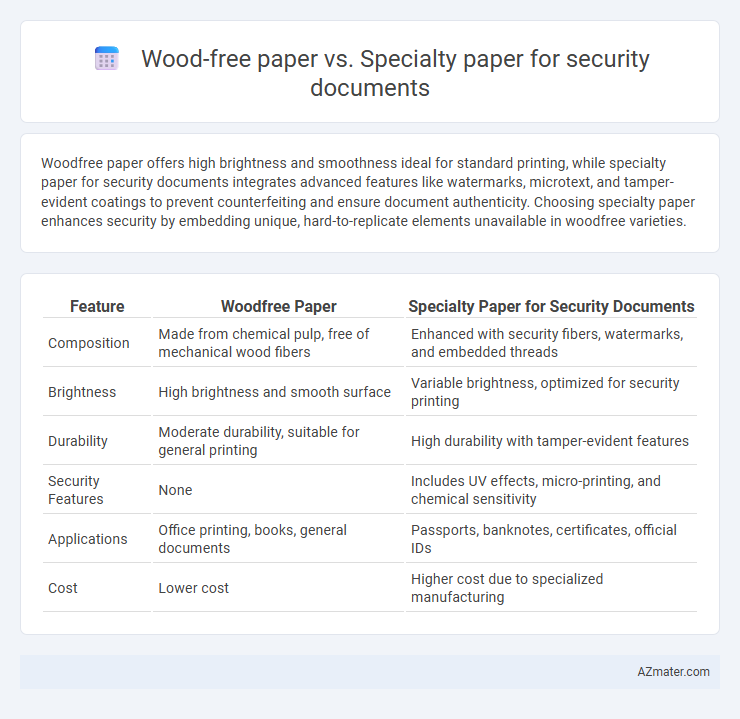Woodfree paper offers high brightness and smoothness ideal for standard printing, while specialty paper for security documents integrates advanced features like watermarks, microtext, and tamper-evident coatings to prevent counterfeiting and ensure document authenticity. Choosing specialty paper enhances security by embedding unique, hard-to-replicate elements unavailable in woodfree varieties.
Table of Comparison
| Feature | Woodfree Paper | Specialty Paper for Security Documents |
|---|---|---|
| Composition | Made from chemical pulp, free of mechanical wood fibers | Enhanced with security fibers, watermarks, and embedded threads |
| Brightness | High brightness and smooth surface | Variable brightness, optimized for security printing |
| Durability | Moderate durability, suitable for general printing | High durability with tamper-evident features |
| Security Features | None | Includes UV effects, micro-printing, and chemical sensitivity |
| Applications | Office printing, books, general documents | Passports, banknotes, certificates, official IDs |
| Cost | Lower cost | Higher cost due to specialized manufacturing |
Introduction to Security Document Paper Types
Woodfree paper, characterized by its high purity and smooth surface, is frequently used in security documents for its durability and print clarity. Specialty paper incorporates advanced features like watermarks, holograms, and embedded threads to enhance protection against counterfeiting. Security document paper types combine these materials to balance usability with robust anti-fraud measures, ensuring authenticity and integrity.
Defining Woodfree Paper for Security Applications
Woodfree paper, characterized by the absence of mechanical pulp, offers high brightness and excellent print quality, making it suitable for security documents requiring clear text and intricate designs. Its smooth surface enhances the effectiveness of anti-counterfeiting features such as watermarks and microprinting. Compared to specialty paper, woodfree paper provides a cost-effective base that supports various security applications without compromising durability or visual clarity.
Overview of Specialty Papers in Security Printing
Specialty papers in security printing incorporate advanced features such as watermarks, embedded fibers, and chemical sensitizers to prevent counterfeiting and unauthorized reproduction. Unlike woodfree paper, which primarily focuses on brightness and smoothness, specialty papers are engineered for enhanced durability and tamper-evidence in documents like passports, banknotes, and certificates. These papers often utilize synthetic fibers or multi-layer constructions to improve resistance against physical and chemical attacks, ensuring higher security integrity.
Physical and Chemical Properties Comparison
Woodfree paper exhibits higher purity and brightness with reduced lignin content, enhancing resistance to yellowing and improved print clarity essential for security documents. Specialty paper incorporates additives like chemical markers, watermarks, and fibers, offering superior strength, durability, and tamper-evident features that standard woodfree paper lacks. Chemically, specialty papers often contain embedded security agents such as fluorescent or UV-reactive compounds, providing advanced protection against forgery and counterfeiting compared to conventional woodfree paper.
Security Features Integration: Woodfree vs Specialty
Specialty paper for security documents offers advanced security features integration such as embedded watermarks, security fibers, and chemical-reactive coatings that are difficult to replicate, ensuring enhanced counterfeit resistance compared to woodfree paper. Woodfree paper, primarily designed for high-quality printing and durability, lacks intrinsic security elements but can be coated or treated to incorporate some basic security features. The inherent properties of specialty paper make it the preferred substrate for high-security applications like banknotes, passports, and certificates where multiple layered security measures are critical.
Durability and Longevity in Security Documents
Woodfree paper, made from chemical pulp with minimal lignin, offers improved durability and reduced yellowing, making it suitable for basic security documents that require moderate longevity. Specialty paper, often infused with synthetic fibers, embedded security features, and chemical treatments, provides superior resistance to wear, tearing, moisture, and tampering, ensuring enhanced durability and prolonged lifespan for high-security documents such as passports and banknotes. The incorporation of watermarks, holograms, and microprinting in specialty paper further enhances its ability to maintain integrity over time, surpassing the durability capabilities of standard woodfree paper.
Cost and Production Considerations
Woodfree paper offers a cost-effective option for security document production due to its lower raw material costs and simpler manufacturing process, making it suitable for large-volume printing with standard security features. Specialty paper, although more expensive, provides enhanced durability, unique textures, and integrated security elements like watermarks and invisible fibers, which justify higher production costs for sensitive documents requiring advanced protection. Production considerations include the need for specialized equipment and quality control processes when working with specialty paper, impacting overall expenses and turnaround times compared to woodfree alternatives.
Printing Compatibility and Performance
Woodfree paper offers high brightness and smooth surface that enhances print clarity, making it compatible with various printing technologies like offset and digital printing for security documents. Specialty paper designed specifically for security applications incorporates features such as watermarks, UV-reactive fibers, and anti-copy patterns, ensuring superior print durability and resistance against tampering. While woodfree paper provides excellent print quality for standard documents, specialty security paper delivers enhanced performance in forgery prevention and long-term document integrity.
Environmental Impact and Sustainability Factors
Woodfree paper, typically produced from chemical pulp with fewer lignin contents, offers higher durability but involves intensive chemical processing that can impact environmental sustainability negatively due to higher energy consumption and pollutant emissions. Specialty paper for security documents often incorporates recycled fibers, biodegradable coatings, and embedded security features like watermarks or fibers, enhancing environmental performance by reducing raw material use and promoting recyclability. Sustainability factors prioritize lifecycle assessments where specialty papers designed for security combine multifunctional durability with eco-friendly materials, resulting in a lower overall carbon footprint compared to traditional woodfree paper.
Choosing the Right Paper for Security Documents
When selecting paper for security documents, woodfree paper offers high brightness and smoothness, enhancing print clarity and durability, making it ideal for everyday security materials. Specialty paper incorporates embedded security features like watermarks, UV fibers, or holograms, providing advanced protection against counterfeiting and tampering. Choosing the right paper depends on the required level of security and document lifespan, balancing cost-effectiveness with anti-fraud requirements.

Infographic: Woodfree paper vs Specialty paper for Security document
 azmater.com
azmater.com